Implementation of the Brain-Based Learning Model in Developing the Creative Thinking Skills of Elementary School Students
Abstract
This study aims to describe the implementation of the Brain-Based Learning (BBL) model in developing the creative thinking skills of elementary school students. The research used a descriptive qualitative approach, with the subjects comprising one teacher and fifth-grade students from SD Negeri 2 Wajak Kidul. Data were collected through observation, interviews, documentation, and analysis of the teaching module, with a focus on creative thinking indicators, including fluency, flexibility, originality, and elaboration. The results of the study show that the learning plan was systematically arranged according to the seven stages of BBL, utilizing visual media, educational games, and authentic assessments to stimulate students’ creativity. The implementation of BBL created an interactive, contextual, and enjoyable learning atmosphere, encouraging active student engagement through discussions, projects, and presentations. Students showed an improvement in creative thinking skills, although the achievement in each indicator varied. The supporting factors of success included teacher readiness, student motivation, and school support. The main obstacles encompassed limited time, technological facilities, and students’ initial adaptation to activity-based learning. In conclusion, the implementation of BBL proved effective in creating a conducive learning environment that aligns with the way the brain works, thereby optimizing the development of creative thinking skills in elementary school students. This model can serve as an innovative learning alternative to improve the quality of Science and Social Science (IPAS) learning in elementary schools



